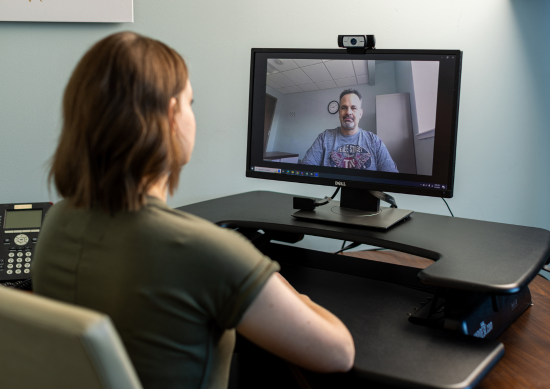
The Nebraska Medicine telestroke network uses electronic audio and video technology to care for stroke patients—both at Nebraska Medicine and at other hospitals throughout the region that don’t have stroke specialists on-site. Telestroke provides real-time expert neurological assessment and recommendation of treatment for patients presenting with stroke-like symptoms.
Kelly-Ann Patrice, MBBS, a vascular neurologist specializing in stroke care, explains how the telestroke network improves outcomes for stroke patients at hospitals throughout the region.
How telestroke works
“Telestroke services connect patients with stroke specialists when they arrive at hospitals that may not have a stroke expert on-site,” says Dr. Patrice. “This helps ensure that patients receive fast, appropriate treatment, which can reduce the risk of long-term disability after a stroke.”
Hospitals in the telestroke network have immediate access to the Nebraska Medicine stroke team at any time. Once the stroke team is contacted, the on-call neurologist will evaluate the patient via video monitors.
Through the telestroke network, the on-call neurologist at Nebraska Medicine can visualize and interpret brain images (CT scans) of stroke patients from other hospitals in the region. The technology has been shown to reduce the amount of time it takes to identify and treat stroke patients with tPA.
“During a video consultation, the patient and family members can see and talk directly with the stroke specialist,” explains Dr. Patrice. “As part of the evaluation, the specialist will ask about the patient’s medical history, perform a neurological exam, and review their brain scans in real time. This allows us to quickly identify the best treatment and support the patient, their family and care team in making important, time-sensitive decisions.”
Once a diagnosis is made, the telestroke neurologist will recommend next steps. This may include giving clot-busting medication (tPA) or stabilizing the patient for transport. Nebraska Medicine also offers the largest group of specialty and fellowship-trained providers in the region to assist patient transfers when needed.
Redefining stroke care
When it comes to stroke care, every second counts. Nebraska Medicine’s telestroke network connects hospitals throughout the Midwest with the region’s only Joint Commission Certified Comprehensive Stroke Center. This makes it possible for patients to receive expert care while staying close to home.
Nebraska Medicine’s telestroke network provides:
- 24/7 stroke coverage with an average response time of less than five minutes.
- Inpatient teleneurology coverage.
- A team of stroke specialists, including neurohospitalists, neurointensivists and neuro-vascular specialists.
- Guidance on clinical workflows and education for local care teams.
- Program feedback with outcomes measured and reported.
- Medical director support for certified stroke centers.
“By implementing focused education initiatives, continuously assessing clinical workflows, and systematically reporting outcomes, the telestroke program aims to consistently deliver timely and high-quality care to stroke patients,” adds Dr. Patrice.
Expanding access and improving care
Montgomery County Memorial Hospital in Red Oak, Iowa, is part of the telestroke network. They receive:
Regular stroke training sessions.
Improved team skills and effectiveness.
Improved community access to specialized stroke care.
"The support from Nebraska Medicine has enhanced our ability to manage stroke cases effectively, ultimately improving outcomes and safety for those we serve," says Hailey Runyon, RN, BSN, Acute Stroke Program Coordinator, Montgomery County Memorial Hospital.
The impact of telestroke:
18% intervention rate for acute ischemic stroke patients.
50% of transferred patients are discharged home with little to no disability.
Nearly 30% of patients treated with thrombolytic therapy can stay in their local hospital.
“Telestroke networks have improved stroke care by expanding access to expert specialists regardless of location, ensuring patients receive timely, life-saving treatment,” says Dr. Patrice. “This technology bridges gaps in care, improves outcomes, and offers critical support to healthcare teams, ultimately transforming the quality and reach of stroke treatment."
For more information about Nebraska Medicine telestroke services, contact Denise Gorski, MHA, BSN, RN, neuroscience clinical programs, quality and accreditation manager, at dgorski@nebraskamed.com.